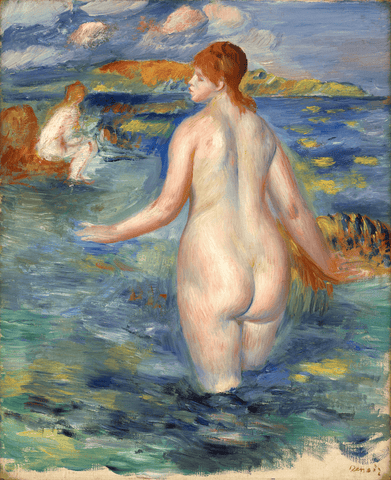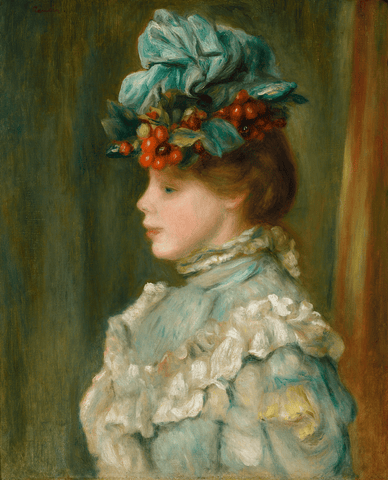Artists & Artisans
Renoir, Pierre-Auguste
Rembrandt, da Vinci, Picasso, Renoir...The difference between artistic talent and artistic genius can often be assessed in a single brushstroke. Without question, Pierre-Auguste Renoir stands at the forefront of history's most recognized and acclaimed artists - a true artistic genius, whose work speaks volumes about the man himself and the world in which he lived.
Born in Limoges, France in 1841, Pierre-Auguste Renoir initially exhibited a love for painting at the young age of 13. While apprenticed to a painter of porcelain wares, he studied famous works in the Louvre during his spare time. Mesmerized by the vivid palette of Eugene Delecroix and the works of the French rococo masters, Renoir embraced the use of vibrant colors and lighthearted themes that would later define much of his life's work.
At the age of 21, Renoir moved to Paris and enrolled at the prestigious Ecole des Beaux Arts. The young french artist studied under Charles Gleyre, whose other students included Claude Monet, Alfred Sisley and Jean-Frederic Bazille. Renoir began meeting and exhibiting with his classmates, along with several other French artists, playing a key role in the formation and development of what is now known as the French Impressionist movement.
Working closely with Claude Monet, Renoir began experimenting with portraying light and its effect on his canvasses. Though he was the youngest member of the French Impressionist artists, Renoir recognized how a subject was constantly changing due to the dynamic effects of light on color. Capturing a particular moment in time, or an "impression," rather than a subjective scene, was central to the group's philosophy. It would become the most important artistic movement of the 19th century.
Renoir began exhibiting his oil painting collection in Paris in 1864, but it wasn't until the first organized Impressionist exhibition ten years later that he gained widespread recognition. His lively, sensual paintings set him apart from his peers and, through his work, Renoir created a modern, carefree image of the French bourgeoisie. Among his most iconic works are "Bal du moulin de la Galette" and "Luncheon of the Boating Party," which exemplify his mastery in capturing the vibrancy and fluidity of social gatherings.
During the 1870s, Renoir enjoyed great success as a portraitist and an inspiring trip to Italy in 1881 led him to develop the increasingly singular artistic style with which we are most familiar today. Renoir's solo exhibition in 1883 at the Durand-Ruel Gallery in Paris confirmed his position as one of the leading artistic masters of the day.
Relying heavily upon composition, lines and descriptive details, Renoir distinguished himself among his contemporaries. His intuitive use of color and expansive brushstroke techniques, along with an acute attention to his subject matter, have placed him among the finest painters in history.
By the turn of the century, the name Renoir was recognized around the world. The successful artist, suffering from rheumatism, moved to the warmth of the south of France and by 1912 was confined to a wheelchair. Renoir continued to paint, and even sculpt, with the help of studio assistants, until his death in 1919.
Renoir had the remarkable ability to translate the ordinary into the extraordinary. His scenes of everyday life were transformed into masterpieces of beauty and light at the hand of this amazing artist. Renoir is not only one of the greatest of the Impressionist artists, but he is considered one of the greatest artists of all time. To acquire a Renoir painting is to own a genuine piece of art history and a true masterpiece. For those interested in owning a piece of this legacy, explore our collection of original Renoir paintings for sale.
Artists & Artisans
Renoir, Pierre-Auguste
Rembrandt, da Vinci, Picasso, Renoir...The difference between artistic talent and artistic genius can often be assessed in a single brushstroke. Without question, Pierre-Auguste Renoir stands at the forefront of history's most recognized and acclaimed artists - a true artistic genius, whose work speaks volumes about the man himself and the world in which he lived.
Born in Limoges, France in 1841, Pierre-Auguste Renoir initially exhibited a love for painting at the young age of 13. While apprenticed to a painter of porcelain wares, he studied famous works in the Louvre during his spare time. Mesmerized by the vivid palette of Eugene Delecroix and the works of the French rococo masters, Renoir embraced the use of vibrant colors and lighthearted themes that would later define much of his life's work.
At the age of 21, Renoir moved to Paris and enrolled at the prestigious Ecole des Beaux Arts. The young french artist studied under Charles Gleyre, whose other students included Claude Monet, Alfred Sisley and Jean-Frederic Bazille. Renoir began meeting and exhibiting with his classmates, along with several other French artists, playing a key role in the formation and development of what is now known as the French Impressionist movement.
Working closely with Claude Monet, Renoir began experimenting with portraying light and its effect on his canvasses. Though he was the youngest member of the French Impressionist artists, Renoir recognized how a subject was constantly changing due to the dynamic effects of light on color. Capturing a particular moment in time, or an "impression," rather than a subjective scene, was central to the group's philosophy. It would become the most important artistic movement of the 19th century.
Renoir began exhibiting his oil painting collection in Paris in 1864, but it wasn't until the first organized Impressionist exhibition ten years later that he gained widespread recognition. His lively, sensual paintings set him apart from his peers and, through his work, Renoir created a modern, carefree image of the French bourgeoisie. Among his most iconic works are "Bal du moulin de la Galette" and "Luncheon of the Boating Party," which exemplify his mastery in capturing the vibrancy and fluidity of social gatherings.
During the 1870s, Renoir enjoyed great success as a portraitist and an inspiring trip to Italy in 1881 led him to develop the increasingly singular artistic style with which we are most familiar today. Renoir's solo exhibition in 1883 at the Durand-Ruel Gallery in Paris confirmed his position as one of the leading artistic masters of the day.
Relying heavily upon composition, lines and descriptive details, Renoir distinguished himself among his contemporaries. His intuitive use of color and expansive brushstroke techniques, along with an acute attention to his subject matter, have placed him among the finest painters in history.
By the turn of the century, the name Renoir was recognized around the world. The successful artist, suffering from rheumatism, moved to the warmth of the south of France and by 1912 was confined to a wheelchair. Renoir continued to paint, and even sculpt, with the help of studio assistants, until his death in 1919.
Renoir had the remarkable ability to translate the ordinary into the extraordinary. His scenes of everyday life were transformed into masterpieces of beauty and light at the hand of this amazing artist. Renoir is not only one of the greatest of the Impressionist artists, but he is considered one of the greatest artists of all time. To acquire a Renoir painting is to own a genuine piece of art history and a true masterpiece. For those interested in owning a piece of this legacy, explore our collection of original Renoir paintings for sale.






